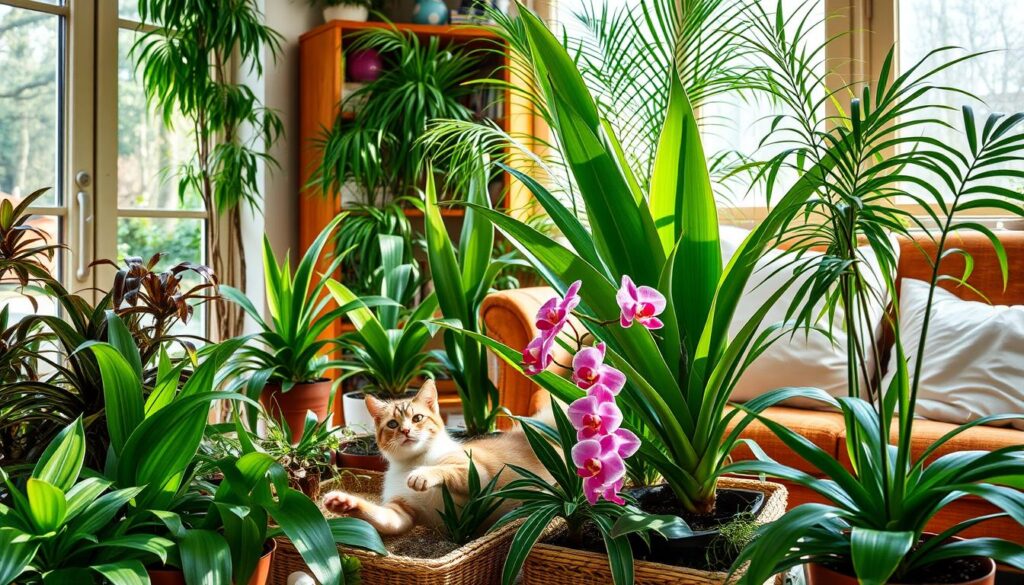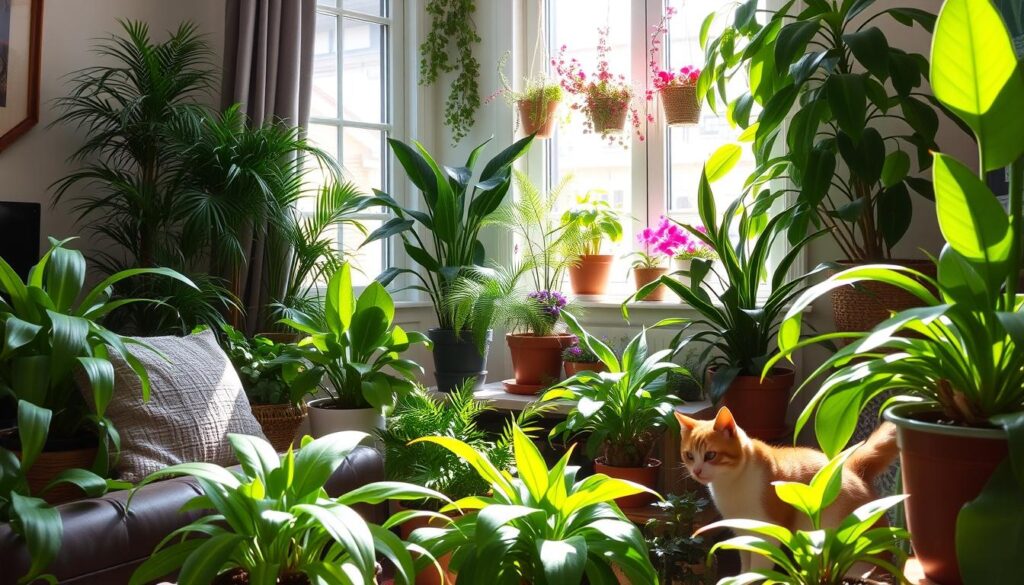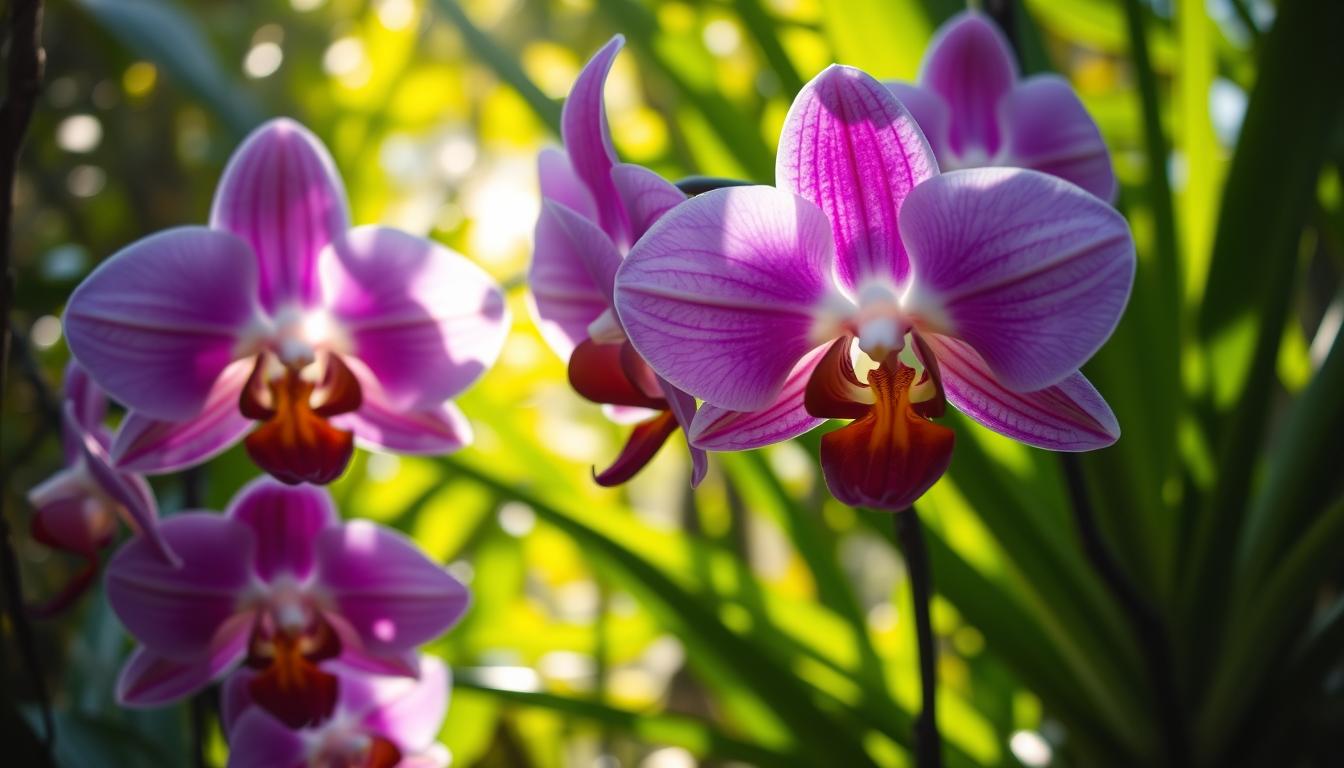Orchids are loved by many for their beauty and variety. With over 25,000 species, they’re a favorite in homes and gardens. But, pet owners might worry, “Are orchids safe for cats?” The answer is mostly yes, but there are a few things to remember.
Orchids come from the Orchidaceae family. Most of these plants are safe for cats. Eating a lot of orchid leaves or stems might upset a cat’s stomach. But, orchids are not harmful to your pets.
Table of Contents
Understanding Orchids as Houseplants
Orchids are now a favorite among indoor plants. They catch the eye with their beautiful blooms and can grow well in many homes. From the elegant Phalaenopsis (Moth orchid) to the vibrant Cattleya and the delicate Epidendrum, these plants add natural beauty to any room.
Types of Common Indoor Orchids
Some popular indoor orchids include:
- Phalaenopsis (Moth orchid)
- Cattleya
- Epidendrum
- Oncidium
Basic Orchid Care Requirements
Orchids need the right light, water, and temperature to grow well indoors. With proper care, they can bloom for weeks or months. This makes them a beautiful and easy-to-care-for addition to any home.
The Popularity of Orchids in Home Decor
Orchids are loved for their beauty and ability to fit into different home styles. Their unique flowers and wide range of colors and shapes make them a standout in any room.
| Orchid Species | Toxicity to Cats | Toxicity to Dogs |
|---|---|---|
| Phalaenopsis (Moth orchid) | Non-toxic | Non-toxic |
| Cattleya | Non-toxic | Non-toxic |
| Epidendrum | Non-toxic | Non-toxic |
| Oncidium | Non-toxic | Non-toxic |
| Cypripedium (Lady Slipper Orchid) | Potentially Toxic | Potentially Toxic |
Are Orchids Safe for Cats: The Definitive Answer
Keeping your feline friends safe is very important. Luckily, orchids are safe for cats. The American Society for the Prevention of Cruelty to Animals (ASPCA) says orchids are non-toxic to cats, dogs, and humans.
Eating orchids might upset a cat’s stomach a bit. But orchids don’t have harmful chemicals or toxins. Still, it’s best to keep cats away from orchids to avoid any tummy troubles.
Orchids are popular for being easy to care for and looking great. They can live safely with cats. By choosing non-toxic flowers for pets, you can enjoy orchids and keep your cats healthy.
Remember, while orchids are safe for cats, not all plants are. Plants like lilies, hydrangeas, and pothos are toxic to cats. Knowing which plants are safe helps you create a safe space for both your pets and plants.
Potential Health Risks from Orchid Consumption
Orchids are usually safe for cats, but eating them can still cause some health issues. Cats might get a bit sick, like vomiting or diarrhea, if they eat a small part of the plant. But, most cats won’t get very sick from eating a little bit of orchid.
Symptoms of Plant Ingestion
Cats might vomit, have diarrhea, drool, or lose their appetite if they eat an orchid. These problems are usually not serious and will go away in a day or two.
When to Contact Your Veterinarian
If your cat keeps vomiting, has diarrhea that won’t stop, stops eating, or seems really down after eating an orchid, call your vet. These ongoing problems might need a vet’s help to figure out what’s wrong and how to fix it.
Treatment Options and Recovery
Most cats with orchid symptoms just need fluids and maybe some medicine to stop nausea. With the right care from your vet, most cats get better fast and without any big problems.
Even though orchids are usually okay, the stuff used to grow them can be bad if cats eat it. To keep your cat safe, don’t let them near plants that could be harmful. Always check if a plant is safe before bringing it home.
The best way to protect your cat is to stop them from eating plants. Keep orchids and other plants where your cat can’t get to them. With a little care, you can enjoy your orchids and keep your cat happy and healthy.
The Truth About Orchid Toxicity Levels
Keeping your feline friends safe means knowing about common household plants. Luckily, orchids are safe for cats and don’t pose a big health risk if they eat them.
The ASPCA says orchids aren’t very toxic to cats. But, eating them might make a cat feel a bit sick. They might vomit, have diarrhea, or drool, especially if the orchid has certain chemicals.
Even though orchids are mostly safe, watch your cat if they try to eat the plant. If your cat gets sick and it doesn’t get better in 24 hours, see a vet. They can help and figure out what to do next.
To stop your cat from eating orchids, put the plants where they can’t reach. You can also use things like citrus sprays or double-sided tape to keep them away. Giving your cat toys can also keep them busy and away from the plants.
Choosing the right orchids for your home is important if you have cats. Dendrobium and Phalaenopsis orchids are good choices. They are less likely to upset your cat’s stomach if they eat them.
| Orchid Toxicity Level | Potential Symptoms | Recommended Action |
|---|---|---|
| Low Toxicity | Mild vomiting, diarrhea | Monitor cat for 24 hours, seek veterinary care if symptoms persist |
| Moderate Toxicity | Severe vomiting, diarrhea, drooling | Seek immediate veterinary attention for decontamination and treatment |
| High Toxicity | Life-threatening symptoms, organ failure | Seek immediate emergency veterinary care |
With so many orchid species out there, it’s key to know the risks. Make sure to keep your cats safe by being careful with your plants.
Hidden Dangers: Fertilizers and Plant Care Products
Orchids are safe for cats, but the fertilizers and pesticides used on them can be dangerous. These products have chemicals like nitrogen, phosphorous, and potassium. These can be very harmful if a cat eats them.
Common Toxic Chemicals in Plant Care
Keeping orchids healthy means being careful with plant care products. Many of these contain harmful chemicals. Cats can get sick from these, showing signs like drooling, vomiting, and breathing problems.
Safe Alternatives for Orchid Maintenance
For your cat’s safety, use organic, pet-safe options for orchid care. Choose natural fertilizers and eco-friendly pest control. This way, your orchids will stay healthy, and your cat will be safe.
“Proper plant care and cat-proofing your home are essential to maintaining a harmonious, safe environment for both your orchids and your beloved pet.”
Why Cats Are Attracted to Orchids
Orchids are a favorite among indoor plants, but they can catch the eye of cats. Cats are drawn to these plants for reasons that are both surprising and natural.
The strong fragrance of many orchids is a big draw for cats. Their sense of smell is very sharp. The scent of these flowers can make cats curious. Also, the movement and texture of orchids can make cats want to explore and play with them.
Cats might see orchids as a source of fiber or nutrition. In the wild, cats eat grass to help with digestion or to graze. Houseplants, like orchids, can fill this need, making cats interact with them.
- Over 28,000 species of orchids have been identified by scientists so far.
- The ASPCA states that there are no known species of orchid that are poisonous to cats.
- The likelihood of a cat getting ill from ingesting an orchid is low, but it may experience symptoms like an upset stomach, vomiting, or diarrhea.
To keep cats away from orchids, it’s important to give them other things to do. This includes cat grass or fun toys. By understanding why cats like orchids, pet owners can protect their plants and keep their pets safe.

Practical Tips for Cat-Proofing Your Orchid Display
Keeping your orchids safe from cats can be tricky. But, with smart placement and deterrents, you can cat-proof your home garden. This way, your cats won’t bother your plants.
Strategic Placement Solutions
To keep cats away from orchids, place them where cats can’t get to. Hang them in baskets or put them on high shelves. You can also make cat-free zones in your home for your orchids.
Deterrent Methods That Work
- Use citrus-based cat repellent sprays around your orchids. Cats don’t like the smell of citrus.
- Try commercial cat deterrent devices that make sounds or vibrations. They can keep cats out of certain areas.
- Give your cats enrichment activities like toys or scratching posts. This keeps them busy and away from plants.
- Grow cat grass for your cats to chew on. It’s safe and green, just like plants.
With these cat-proofing techniques, you can enjoy your orchids. And your cats will stay safe and happy.
Safe Alternatives: Cat-Friendly Plants
Want to add some greenery to your home without worrying about your cat? Check out these cat-friendly houseplants and pet-safe indoor plants. They can make your space look great while keeping your cat happy and healthy.
Orchids might not be the best choice for homes with cats. But, there are many other plants that are safe and look good. Spider plants, for example, are safe for cats but might upset their stomach if eaten too much. Other good options include cat grass, catnip, and herbs like cat mint or cat thyme.
Make sure to avoid plants that are toxic to cats, like lilies, tulips, and aloe vera. Always check if a plant is safe before bringing it home to keep your cat safe.
For a fun touch, consider the Chinese Money Plant (Pilea peperomioides). It has coin-like leaves and doesn’t harm cats. It likes medium to bright, indirect light and only needs watering every one to two weeks. The Money Tree (Pachira aquatica) is also a good choice, believed to bring luck and fortune.
Hoya plants are also great for cat-friendly homes. They come in many shapes, sizes, and colors. From the classic hoya carnosa to the curly-leaved hoya linearis, they’re sure to please both you and your cat.
If you love flowers, choose cat-friendly ones like African Violets, Roses, Gerbera Daisies, Snapdragons, Zinnias, and Marigolds (Calendula). With the right care and placement, you can add these colorful flowers to your home safely.
Creating a safe space for your pet means doing your research, placing plants carefully, and giving your cat other things to do. By picking the right cat-friendly houseplants and pet-safe indoor plants, you can make a beautiful, safe space for your cat.
| Plant Name | Toxicity Level | Care Requirements |
|---|---|---|
| Chinese Money Plant (Pilea peperomioides) | Non-toxic | Water every 1-2 weeks, medium to bright indirect light, rotate 180 degrees to grow symmetrically |
| Money Tree (Pachira aquatica) | Non-toxic | Place in medium to bright indirect light, water every 1-2 weeks |
| Hoya Varieties (Hoya carnosa, Hoya linearis) | Non-toxic | Resilient plants, suitable for higher-light rooms, various shapes, sizes, and colors |
| African Violets, Roses, Gerbera Daisies, Snapdragons, Zinnias, Marigolds (Calendula) | Non-toxic | Specific sunlight, watering, and soil requirements for each plant type |

Conclusion
Orchids are safe for cats and make great houseplants for pet owners. They might cause a little stomach upset if eaten. But, they don’t pose a serious health risk to your cats.
It’s key to be careful with plant care products. Also, don’t let your cats eat any houseplants. Some common chemicals and other plants can be toxic.
By being careful and choosing safe plants, you can enjoy orchids. Safe plants include Bamboo Palm, Spider Plant, Boston Fern, and Ponytail Palm. This way, you can keep your cats safe while enjoying your home’s beauty.
Remember, always watch your cats around plants. Keep any harmful plants out of their reach. Orchids are a great choice for homes with cats, needing no worry if eaten.
With the right care, you can make a safe and beautiful home for you and your pets. This way, everyone can enjoy a happy and healthy living space.

